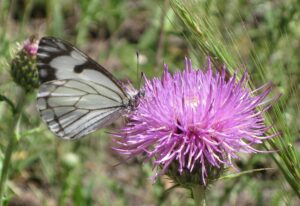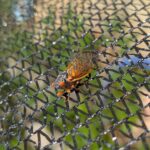Most bonsai pests don’t lay their intentions out in the open. Spider mites hide under foliage. Root aphids go unseen until it’s too late. Scale insects wear armor. But every once in a while, a pest will leave a sign so obvious it feels like a dare.
That’s what I thought when I saw three tight rows of pale, pinhead-sized eggs laid right down the length of a Scots pine needle on my bench. At first glance, I assumed sawfly. It looked like the classic needle zipper—sawfly oviposition sliced neatly into the tissue. But on closer inspection, there were no slits. No swelling. No sign of insertion. Just dozens of neatly placed domes on top of the needle, like tiny suction cups glued down with intent.
That’s not sawfly work. That’s butterfly.
And that raises a new question: Is the pine butterfly a problem in bonsai?
In the wild, it barely registers. But on a refined pine you’ve spent years shaping? It absolutely matters.
The Pine Butterfly: A Closer Look
In western North America, the most likely suspect is the pine white butterfly, Neophasia menapia. These show up in late summer through early fall, floating around mature pines in forested areas. You’ll know them if you see them—delicate white wings with black edging, slow flight, not exactly stealthy. But their eggs are a different story. Females lay clusters of them in overlapping rows, usually along older needles, sometimes younger ones. The eggs are pale, porcelain-like domes with shallow dimples. They stick to the needle with a fast-drying glue and stay there all winter long.
When spring arrives, they hatch. Tiny green caterpillars emerge and begin feeding either immediately or after a short dormant stage. Early in the cycle, they may feed in loose groups, but soon they disperse and nibble on their own, one needle at a time. On mature pines in the forest, this usually goes unnoticed. But when it happens on a bonsai? That one needle matters.
According to the Oregon Department of Forestry, Neophasia menapia larvae feed for a few weeks in spring and early summer, and pupate shortly after. Adults emerge in late summer and begin the cycle again. Most years, population levels are low and impact is minimal—but periodic outbreaks can occur, particularly after mild winters and dry springs12.
Why They Matter in Bonsai
In forestry, a pine butterfly outbreak is a blip. It’s uncommon, localized, and rarely long-lasting. A tree loses 20% of its needles? It’ll recover. That’s not the case with bonsai. On a miniature tree where every needle plays a role in the balance of energy and design, one caterpillar can do real damage.
A bonsai pine in refinement relies on controlled needle density to preserve interior buds and distribute energy. If a caterpillar chews five needles off a single branch—especially interior ones—that entire shoot might weaken or die. You don’t have the same redundancy a forest tree does. One bite at the wrong time ruins six months of careful growth.
The other issue is timing. These caterpillars feed quietly, often under overcast skies or at night. You may never see them. But you’ll notice the missing needles. You’ll blame sunburn, or drought, or spider mites. By the time you realize it’s a caterpillar, the damage is done.
Identifying the Eggs
This is where pine butterfly stands out. The eggs are visible—very visible—and that gives you a fighting chance.
In my case, I found three full rows, spaced neatly across the surface of a single Scots pine needle. They weren’t embedded. No resin, no swelling, no cut marks. Just white domes, like grains of rice pressed into the surface. There were at least 60 of them.
This is a dead giveaway that it’s not sawfly. Sawfly eggs are laid in a single file, partially buried just beneath the epidermis. You’ll often see a swollen seam or scar along the needle. Not here.
Butterfly eggs are:
- Dome-shaped, sometimes with a shallow central dimple
- Laid on top of the needle surface, not embedded
- Found in multiple parallel rows (often 2–4)
- Often more numerous (30–80 per cluster)
- Not associated with resin or sap
If you see this pattern, remove that needle. Do it right away. There’s no benefit to waiting, and if they hatch, you’ve got a whole new problem.
Larval Stage
Once they hatch, the caterpillars are small—maybe a quarter-inch long—greenish or grayish with black heads. They don’t cluster like sawflies. They feed alone, one needle at a time, typically starting with older growth. Over time, their feeding can spread to younger shoots, but they rarely cause widespread defoliation unless populations are high.
They grow slowly, molting a few times before dropping to the ground to pupate in bark cracks, soil debris, or duff near the trunk. Then they vanish until the butterflies emerge again in late summer.
Treatment and Control
If you catch the eggs before they hatch, you’re in control. The best move is mechanical—cut the affected needle and destroy it. I usually drop mine into a jar of rubbing alcohol and leave them there overnight.
If the larvae have already hatched and begun feeding, you have two solid organic options:
Bt (Bacillus thuringiensis kurstaki)
Bt is a microbial insecticide that specifically targets caterpillars in the Lepidoptera order. It works by destroying the lining of their digestive tract once ingested. Caterpillars stop feeding within hours and die in a couple of days. It’s harmless to beneficial insects, birds, pets, and people. Apply it to the areas of the tree where larvae are feeding. Reapply every 7–10 days during active feeding periods3.
Spinosad
Spinosad is another biologically derived insecticide, made from soil-dwelling bacteria. It affects the nervous system of caterpillars and other soft-bodied pests on contact or ingestion. It acts faster than Bt but can be slightly harsher on non-target insects, so avoid spraying when pollinators are active.
Manual removal
Still the best method for light infestations. If you see a caterpillar, pluck it. If you’re squeamish, use tweezers. They don’t move fast and they don’t bite. A caterpillar caught early saves a branch from months of recovery.
Avoid systemic insecticides unless you’re desperate. They work, but they also affect soil microbiota and beneficial insects. For a pest that shows up only once in a while, it’s overkill.
Prevention
There’s no guaranteed way to keep pine butterflies from landing on your trees. They fly, and they’re opportunistic. But you can lower the odds and catch them early.
- Inspect regularly:
From late summer into early fall, check your pine needles closely. Especially older needles and shaded interior branches. Look for the classic egg rows. - Encourage predators:
Birds, spiders, and predatory wasps all eat butterfly larvae. Keep your bonsai area biologically active. Don’t spray broad-spectrum insecticides that wipe out everything. - Rotate tree positions:
Butterflies often return to familiar places to lay eggs. Moving your trees around between seasons can throw them off. - Keep benches and soil clean:
Pupation often occurs in bark cracks or soil litter. Remove fallen needles, weeds, and mossy buildup beneath trees where caterpillars might hide. - Act early:
As soon as you see eggs, remove them. The best treatment is always prevention.
A Pest Worth Watching
Pine butterfly isn’t going to take out your entire collection. This isn’t pine wilt or red spider mite. But it is one of those low-key, under-the-radar threats that shows up when your attention is elsewhere. And that makes it worth knowing.
If you’ve never seen their eggs before, start looking. Once you’ve seen them, you won’t miss them again. Their neat, geometric rows practically glow against the deep green of pine needles.
And once you’ve seen them, you know what to do.
Watch your needles. Pay attention to the quiet parts of the canopy. And remember: just because a pest is small doesn’t mean it can’t throw off a whole season’s worth of growth.
In bonsai, subtle matters.
Sources
- Oregon Department of Forestry – Pine Butterfly (Neophasia menapia) Forest Health Fact Sheet
https://www.oregon.gov/odf/Documents/forestbenefits/PB_2017.pdf ↩︎ - Pacific Northwest Pest Management Handbooks – Pine White Butterfly
https://pnwhandbooks.org/insect/hort/landscape/hosts-pests-landscape-plants/pine-pinus-pine-white-butterfly ↩︎ - National Pesticide Information Center – Bt General Fact Sheet
https://npic.orst.edu/factsheets/btgen.html ↩︎


